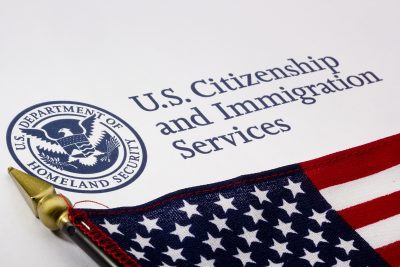Innovation and STEM Fields
For America to compete in the 21st century, we need a robust innovation economy—which requires a workforce skilled in the science, technology, engineering, and math (or STEM) fields. Yet American students are not entering those industries in sufficient numbers, and the United States is projected to face a shortage of one million STEM workers by 2022.1 Foreign-born students frequently gravitate towards STEM disciplines, making up roughly one out of every three individuals earning graduate-level STEM degrees each year. Our broken visa system, however, makes it difficult for many of them to stay after graduation—a reality that hurts the ability of our employers to expand and create more opportunity for American workers. 1 President’s Council of Advisors on Science and Technology, "Engage to Excel: Producing 1 million Additional College Graduates with Degrees in Science, Technology, Engineering, and Mathematics," February 2012. Available online.

From Sao Paulo, Brazil to Toledo, OH: A Civil Engineer Dedicates His Career to His New Home
Fernando Camargo almost didn’t come to Toledo. He was a 16-year-old exchange student from Sao Paulo, Brazil, a bustling city of 12 million in Brazil, when his high school advisor pointed out a tiny town outside of Toledo and said a family there had chosen him. Read More

New American Economy Launches Ticket Sales and Announces Additional Talent for the New American Festival
NEW YORK – Today, ticket sales go live for New American Economy (NAE)’s inaugural New American Festival, a groundbreaking event celebrating immigrant contributions to American art, food, film, comedy, fashion, and more (September 14-15). The festival will feature a keynote address from New York Times best-selling author, host, and executive… Read More

New Data Shows Immigrants Made Up Nearly 30 Percent of STEM Workers in North Texas in 2017
GRAPEVINE, TX – New data from New American Economy (NAE) shows that immigrants make up nearly 30 percent of North Texas’s science, technology, engineering, and math (STEM) workers. The report, which looks at immigrant contributions to the North Texas workforce, tax base, and major industries, was released at… Read More

Dallas Morning News Opinion: Unfair immigration policies are hurting economic growth in Texas
I often hear from business owners that current immigration policies are affecting their bottom line. And as head of the North Texas Commission, an organization dedicated to advancing the region, that’s the last thing I want to hear. North Texas has one of the most diverse economies in the state… Read More

New Report Shows Immigrants in Lowell Accounted for Nearly 90 Percent of Recent Population Growth
Lowell, MA – Immigrant households earned nearly $1.5 billion and contributed $402 million in taxes in 2017, according to new research by New American Economy (NAE) in partnership with the Lowell Refugee and Immigrant Support and Engagement (RISE) Coalition and the Greater Lowell Chamber of Commerce. The report also finds… Read More

Crain’s Chicago Business Opinion: Illinois job creators need this immigration act now
As the founder of a Chicago-based customer experience and digital agency, finding skilled employees is one of my company’s biggest obstacles to growth. My industry calls hiring “a battle for talent,” because tech companies compete so fiercely over increasingly fewer qualified candidates on the market. As a result, it can… Read More

New Report Shows A Quarter of STEM workers in Mecklenburg County Are Immigrants
Mecklenburg County, NC – Immigrant households earned nearly $4.9 billion and contributed over $1.2 billion in taxes in 2017, according to new research by New American Economy (NAE) in partnership with the City of Charlotte. The report illustrates the impact… Read More

New Report Shows Immigrants in Northern Kentucky Contributed Over $116 Million in Taxes
Fort Mitchell, KY – Immigrant households in Northern Kentucky earned nearly $430 million and paid over $116 million in taxes in 2017, according to new research by New American Economy (NAE) in partnership with the Northern Kentucky Chamber of… Read More

Bowling Green Daily News: Strategies being developed to keep workers in area
A multiyear effort to keep more non-native residents of Warren County working closer to home has entered the next phase. New Americans – immigrants and refugees – have higher employment rates than native Americans, and with thousands of job openings in Warren County, the city of Bowling Green has been… Read More

New Report Shows Immigrants in Roanoke Contributed Over $75 Million in Taxes in 2017
Roanoke, VA – Immigrant households earned nearly $304 million and contributed over $75 million in taxes in 2017, according to new research by New American Economy (NAE) in partnership with the City of Roanoke and Local Colors, a non-profit that celebrates the city’s… Read More
Outsize Role in the Workforce
Immigrants punch above their weight class in the STEM fields, making up far larger portions of the STEM workforce than they do the U.S. population overall. This dynamic is particularly pronounced in several states. In New Jersey, for instance, immigrants make up almost two out of every five STEM workers, while accounting for only one in five of the state’s residents.
States with the Highest Share of Foreign-Born STEM Workers, 2014
Labor Shortages
In recent years, many U.S. employers have struggled to find enough STEM workers. This lack of manpower has real consequences for the economy—making it difficult for firms to expand and create jobs for American workers at all skill levels. In several specialized fields, like physical science and software development, the unemployment rates of U.S.-born STEM workers are particularly low, indicating there are simply not enough U.S.-born workers to meet the needs of employers.
Take a look at our latest research about the shortage of STEM workers.
U.S. Citizen Unemployment Rates in STEM Fields Most Heavily Reliant on Immigrant STEM Workers, 2014
Earning STEM Degrees
International students make up a large share of STEM graduate students. In 2014, more than a quarter of STEM master’s degrees and more than a third of STEM Ph.D. degrees went to students in the country on temporary visas. Meanwhile, the number of American citizen and permanent resident students pursuing graduate degrees in science and engineering fields actually fell by 6.3 percent between 2010 and 2013.2 Our broken immigration system means that many of these international students will struggle to remain in the country after graduation, despite employers needing them.
Sources:
2 National Science Foundation, Science and Engineering Indicators, 2016, Appendix Table 2-25. Available online.
Share of Ph.D.'s in Selected Fields Going to Students on Temporary Visas, 2014
States Graduating the Most STEM Students on Temporary Visas, 2014
States Needing STEM Workers
While every state was short STEM workers in 2015, the shortage was particularly acute in North Dakota and South Dakota, where employers listed 87 and 71 STEM positions, respectively, for each unemployed STEM worker. These are gaps that immigrants could help fill. In South Dakota, for instance, immigrants made up just three percent of all STEM workers in 2015, one of the lowest shares in the country.
States with Greatest Shortages of STEM Workers, 2014
Creating U.S. Jobs
Rather than reduce the number of jobs available to American workers, foreign-born STEM graduates often create additional jobs for U.S.-born workers. Research shows that when a state gains 100 foreign-born STEM workers with graduate-level training from a U.S. school, an average of 262 jobs are created for U.S.-born workers there in the seven years that follow.3 More specifically, the temporary visa (H-1B) program for high-skilled workers is also linked to job creation for American workers and economic growth. However, the current system fails not only to provide visas that companies need to grow, but also to protect against fraud and abuse.
Sources:
3 Madeline Zavodny, “Immigration and American Jobs,” The Partnership for a New American Economy and the American Enterprise Institute, 2011. Available online.
States that Stand to Gain the Most from Retaining More Foreign-Born STEM Graduates
The Impact of our Broken Immigration System
Since the recession, some of the most robust growth in high-wage, American jobs has occurred in cities. The high-tech companies fueling this growth cannot succeed and grow, however, without qualified STEM professionals—a group that can be difficult to find. An annual cap on the number of available green cards and H-1B visas hinders efforts to hire immigrant STEM professionals when no American workers are available. At right, we explore how the H-1B requests for computer-related workers that did not make it through the 2007 and 2008 H-1B visa lotteries impacted wages and the number of jobs available for U.S.-born tech workers in the two years that followed.4
Sources:
4 Partnership for a New American Economy, “Closing Economic Windows: How H-1B Visa Denials Cost U.S.-Born Tech Workers Jobs and Wages During the Great Recession," June 4, 2014. Available online.
Metropolitan Areas Hurt Most by 2007 and 2008 Denials in the H-1B Lottery
Driving Innovation
International STEM students and graduates are behind some of America’s most impressive innovations, from artificial skin to moldable metal. Studies show that immigrants with an advanced degree are three times more likely than U.S.-born graduate degree holders to file a patent. When universities increase their share of international students, they often receive more patents—boosting revenue and creating more opportunities for all students.
Share of Patents Awarded to Top Patent Producing Research Universities with at Least One Foreign-Born Inventor, 2011
Make a contribution
Make a direct impact on the lives of immigrants.
